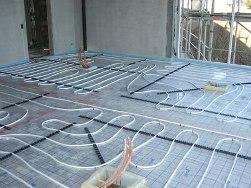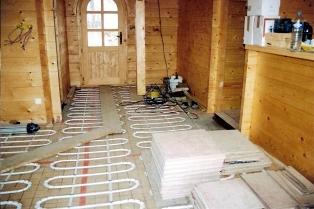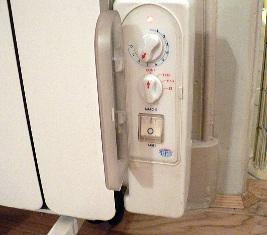Categories: Sharing experience, Electrician at home
Number of views: 43888
Comments on the article: 2
How to build a warm floor on your own. Tips of an experienced electrician
 Warm floor. What is it? This is comfort, coziness, profitability ... The article gives some tips and recommendations from an electrician with experience. Read it, think it over and you will understand whether you can build a “warm floor” on your own ...
Warm floor. What is it? This is comfort, coziness, profitability ... The article gives some tips and recommendations from an electrician with experience. Read it, think it over and you will understand whether you can build a “warm floor” on your own ...
Let's define the term "warm floor". What is it and what does it eat with.
Warm floor - This is a room heating system, which is increasingly being assembled during the construction and repair of apartments, houses, offices.
There are two main types of underfloor heating: the first is electric and the second type is water heated floors, where water circulating through pipes that are mounted in the floor screed during the construction process acts as a heat carrier.
Warm floors can be used as the main type of space heating, as well as auxiliary to the existing one.
Let us dwell on the heating system using electricity.
Today, there are several types of heating systems of this type - this is a cable system where it is used self-regulating heating cable. Cable thickness from 3 to 10 mm. For ease of installation, some manufacturers make systems in the form of mats. And the second type is the so-called “warm” or “heating film”, which we will talk about in the next article.
So, how do you build a warm floor on your own? Is it possible? What is needed to know and be able to do this?
Everyone knows that a correctly asked question contains half the answer. Read what is written below, and you will understand that to build warm floors with your own strength is within the power of everyone, there would be a desire, time and a little skill. Here are some simple tips that you can use to achieve the desired result.
Before starting installation, you need to know the arrangement of furniture, the purpose of the room, how the system will be used - as the main heating of the room or, as an addition to the existing one. Next, you need to make the floor screed as high-quality as possible, the less roughness and unevenness, the better.
In order not to heat the neighbors from below the ceiling, it is necessary to make high-quality thermal insulation. A well-made insulation will greatly increase the efficiency of the installed system, which in turn will significantly save on electricity in the future.
As a thermal insulation, many use "penofol" and similar materials, where instead of reflecting foil aluminum spraying is used. But, as practice shows, cement corrodes spraying, and as a result, the heat-reflecting effect is significantly reduced.
The most optimal solution in this situation is the use of polystyrene with a density of 25, 30 mm thick. As a reflector, it is best to use aluminum foil, specially designed for laying under underfloor heating.
During the installation process it is necessary to step back from the wall 15-20 cm, this is the so-called “dead zone", and why do you need to heat the walls, it is better to make the distance between the turns a little smaller, which will increase the heat transfer of the floors. If you know the exact location of the furniture, step back from the estimated edge of the furniture 10 cm, this will protect your furniture from drying out, thereby prolonging its (furniture) service life.
Before buying a heating cable, measure the area of the room as accurately as possible, and, based on the received figure, it is worth choosing the cable length. The cable is sold ready-made for a certain area, you cannot extend or shorten it yourself. For ease of installation, we recommend choosing a two-wire cable, which will greatly simplify the installation process.
In kit with heating cable reputable manufacturers, as a rule, includes: mounting tape, temperature sensor, temperature controller, installation instructions. One of the well-known manufacturers of “underfloor heating” even put in a product packaging a video disc with installation instructions, where the entire installation procedure is quite intelligibly and clearly shown.
Read also on this topic:How the electric heat-insulated floor is arranged and works
When using the cable as an additional, comfortable, heating, the distance between the turns is 10 -12 cm. If you decide to use the "warm floor" as the main heating, then, accordingly, the distance must be reduced to 7-8 cm. This should also be taken into account when buying.
For fixing the cable to the floor, the kit includes a special mounting tape. But we would recommend you use a galvanized metal mesh. Firstly, the mesh will significantly increase the strength of the coupler and, secondly, it simplifies the fastening of the cable.
A temperature sensor is placed between the turns of the heating cable. The sensor itself is placed in a tube that is mounted with the cable. One end of the tube is hermetically sealed, the other end of the tube is brought into a dose box, which must be installed 25-30 cm from the floor. The temperature sensor should move freely along the tube. The power supply for the heating cable is also displayed in the same box.
And one more free and practical advice. As practice shows, if the area of the room where you are going to install a warm floor is relatively large, it makes sense to divide this room into zones. A good example in this case is the kitchen studio. This room can be divided into a working area and a recreation area, and accordingly to divide the "warm floor" into several independently heated areas.
Screed. What you need to pay attention to. The solution with which the cable is poured must be made more liquid so that voids do not form around the cable. In the event that air remains around the cable, it is likely that in this place it will simply overheat and burn. As a result, the entire system will fail.
The thickness of the screed should be no more than 3-5 cm, a deformation seam must be made near the walls in order to avoid “uplifting” the floors.
According to the technology, the screed dries completely in 28-32 days, only after this period has elapsed and you can turn on the electric “warm floor”. If you turn it on earlier, the floor will crack, and the moisture released during heating will form a void around the cable, which will be described later.
You can quickly find out all the subtleties and nuances of installing electric heated floors here:Installation technology for electric underfloor heating
Sergey Seromashenko
See also at e.imadeself.com
:


